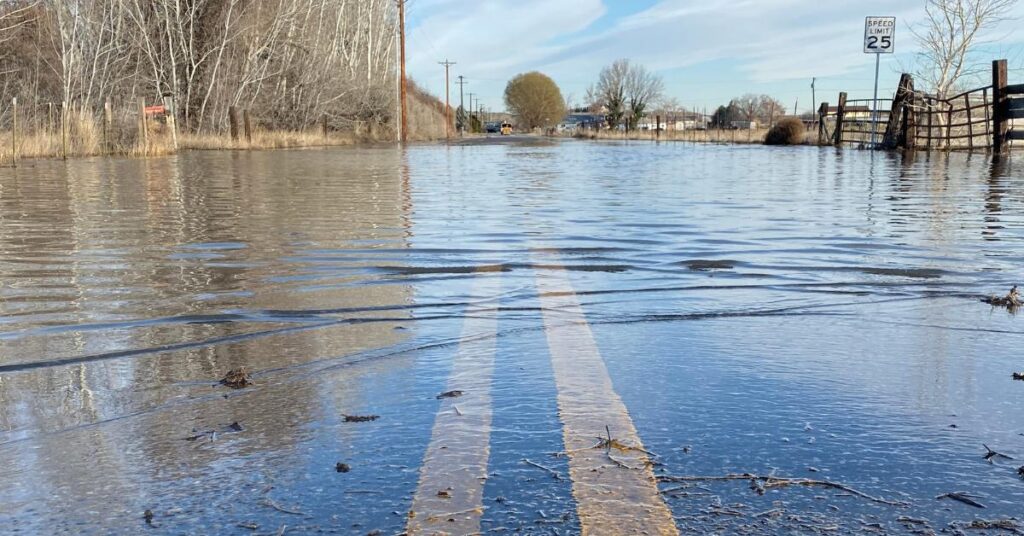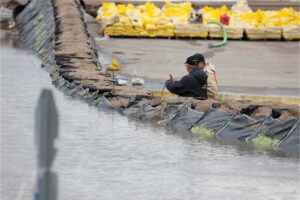How to Protect Roads from Flooding
Cities strategize about how to protect roads from flooding to prevent flood road closures. Learn how flood barriers like TrapBag can mitigate road flooding.

Flooded roads are a dangerous force to be reckoned with. Deep road flooding can destroy car engines, wash away vehicles, and leave citizens stranded. It is also incredibly unsanitary and can contain hazardous materials like downed power lines, biohazardous waste, and chemical contaminants.
Flood preparedness for cities and towns needs to include a plan of action for street flooding. A quarter of roads and critical buildings in the United States would be impassable during a flood. Roads are an essential part of our infrastructure, and we rely on them to go to work, obtain groceries, and receive medical attention in emergencies. The dangers of driving through flooded roads are more serious than meets the eye. Learn how flood barriers and other methods can prevent road flooding and keep drivers safe.
Methods for Preventing Road Flooding
Elevated Roads
Road flooding can be prevented early on during the planning stages of city development. Civil engineers should examine yearly weather patterns and water levels when developing infrastructure plans. If an area near a body of water has consistent flooding each spring, city developers would be wise to create elevated roads above predicted flood levels that aren’t vulnerable to collecting large pools of rainwater. This helps to avoid flooding during seasons of heavy precipitation.
Rain Barrels
An option for collecting floodwater before it pools is placing rain barrels on the side of the road. These provide a concentrated location for water collection and contain rain that would otherwise pool on the street. Rain barrels are best utilized in specific areas that experience mild to moderate flooding rather than long stretches of road.
Clean Streets
Built-in water diversion systems can’t function properly if they’re clogged up. Keep the shoulders and storm drains of roads clear of debris to reduce the severity of flooding. Cleanup teams can be commissioned by the county or enlisted with the help of volunteer organizations to maintain the integrity of major roadways.
Nearby Vegetation
Urban areas like New York City and Philadelphia experience frequent flooding because of the concentration of concrete and buildings. With so much cement, there is little room for plant life aside from the occasional patch of grass on a median or trees and shrubbery in a small park. Vegetation and soil absorb water, so the lack of plant life can be detrimental to a city’s flood levels.
Creating an initiative to make a city greener will not only beautify the area but also reduce road flooding by soaking up rainwater and runoff. Plant trees and shrubbery by the sides of roads and install as many medians as possible to prevent flooded roads.
Floodways
Regulatory floodways are reinforced floodplain crossings for roads built at a standard ground level. They are designed to withstand being submerged under floodwater. A floodway serves as a drainage path that reduces the severity of flooding and keeps vehicles safe from water damage, but it may not prevent road shutdowns during flooding seasons.
Flood Mitigation with Flood Bags
Stop Flooded Roads at the Source
Stopping a problem at its source is an effective method of flood prevention. Install flood barriers like TrapBag® along the banks of rivers and lakes to prevent flooding of an entire area rather than focusing just on road flooding mitigation. While this method may require more flood barriers and an increased budget, it will help to preserve wildlife and ecosystems from flood damage.
Install Along the Road
If there’s a particular area of a road that keeps flooding, installing flood barriers along the side of the street can prevent water from pooling. Invest in flood bags to keep near roads with low elevations to raise the waterline during flooding seasons. Avoid the dangers and costs of flooded streets by installing prevention systems like TrapBag.
Prevent Road Flooding with TrapBag Flood Barriers
Learn how to protect roads from flooding with TrapBag flood barriers. Towns can be adequately prepared for flood mitigation with the emergency deployment capabilities of our products. Our flood bags are designed to be rapidly installed along the area that requires flood protection, then filled with your choice of sand, concrete, or washed gravel.
TrapBag offers longevity, durability, and cost-effectiveness. Our products last at least five years and are made of a high-strength textile. The design of our flood barriers was created with resilience in mind. The pentagonal bags are connected in a network of cells, reinforcing strength in the cells next to one another without compromising the integrity of the structure if one bag is punctured.
Browse our shop and order top-grade products to prevent flooded roads from becoming a major problem in your town. Preparedness is empowering, and your infrastructure needs protection when storms and natural disasters strike.
Frequently Asked Questions
How Can I Find Out About Flooded Roads Near Me?
Several local and national weather websites keep track of flood road closures, as well as directories that connect drivers to phone numbers and websites with information about road conditions. Mobile apps like Waze help drivers by warning them when six inches or more of water has collected on a specific road.
Local radio stations, news stations, and weather channels also provide information about flood road closures, but audiences need to either tune in daily or listen at the right time.
How Long Does It Take for Flooded Roads to Clear?
Depending on the severity of the flood, it may take several days before roads are reopened after a flood event. The length of time it takes for flooded roads to clear depends on the depth of floodwaters as well as the amount of debris and other obstacles blocking the roadway. If there are efforts to clear out the roadway, it will be safe for driving sooner than relying on evaporation and drainage alone.
How Deep of Water Is Unsafe to Drive Through?
Because vehicles are heavy and considered to be tough machines, most people assume they can handle quite a bit of water. However, cars can be swept away more easily than you think. Just six inches of water can damage your vehicle and make you lose control, while a full foot of water can cause many vehicles to float away. If you are unsure about the depth or safety of water on the road, call your local traffic safety advisory commission, and when in doubt, change your route.
Prevent Road Flooding

Flooding on roadways can become an extremely dangerous situation for drivers. Ensure your town is adequately prepared for flood mitigation with the emergency deployment capabilities of TrapBag.
